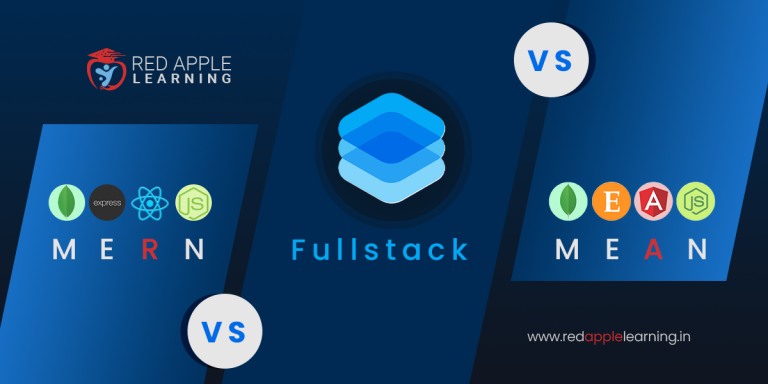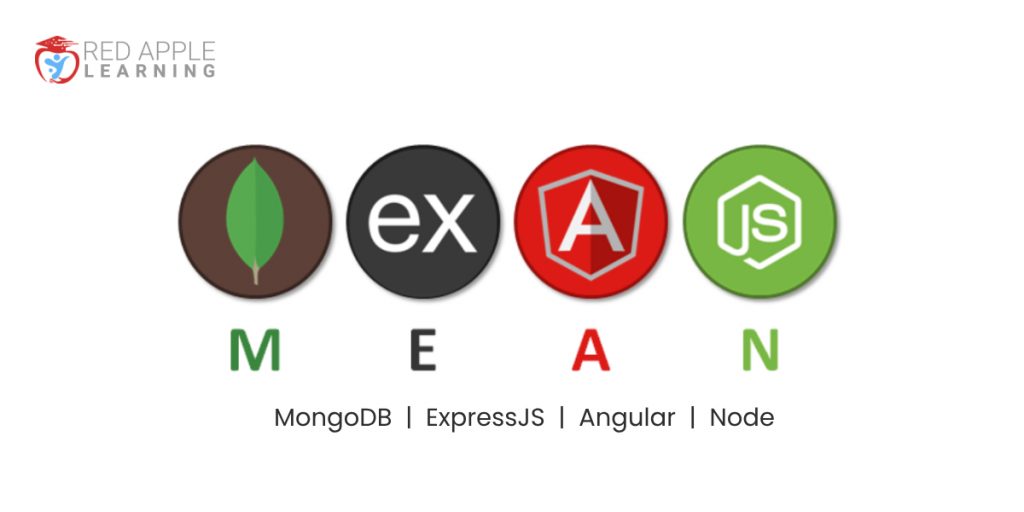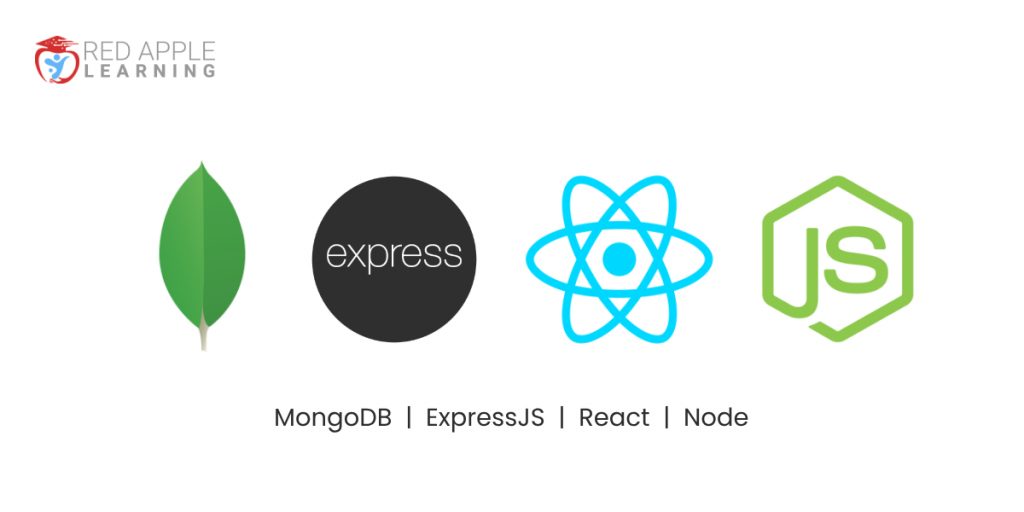Full-Stack vs MEAN Stack vs MERN Stack: Which One Should I Learn

In the world of web development, there are several stacks that developers can choose from to build robust and efficient applications. Three popular stacks that have gained significant popularity in recent years are Full-Stack, MEAN Stack, and MERN Stack. Each stack has its own unique advantages and use cases. Although, it is important to know the fact that full-stack development has emerged as a game-changer, offering professionals the ability to work on both front-end and back-end technologies. Therefore, in this blog, we will explore the differences between these stacks and help you make an informed decision on which one to learn based on your specific needs and goals.
But first, let’s Categorize Each Stack Properly:
- MEAN (MongoDB, Express.js, AngularJS, Node.js)
- MERN (MongoDB, Express.js, React, Node.js)
- FULL- STACK (Front end+ back end languages+ APIs+ MySQL and the list continues…)
What is MEAN STACK?

MEAN stack refers to a collection of technologies that are combined together to create a web application. It is the amalgamation of 4 different technologies. Here’s the breakdown:
- MongoDB:A NoSQL database system that stores data in a flexible, JSON-like format.
- js:A web application framework for Node.js that provides a set of tools and features to build server-side applications.
- Angular:A JavaScript framework for building dynamic and interactive web applications.
- js:A JavaScript runtime environment that allows you to execute JavaScript code outside of a web browser, making it possible to build server-side applications.
When combined, these technologies together enable developers to build full-stack web applications using JavaScript throughout the entire development process. MongoDB serves as the database to store and retrieve data, Express.js provides the backend infrastructure and handles HTTP requests and responses, Angular handles the frontend user interface and interaction, and Node.js acts as the runtime environment for executing the server-side code.
By utilizing the MEAN stack, developers can work with a single programming language (JavaScript) for both frontend and backend development, which can streamline the development process and improve overall productivity.
What is MERN STACK?

The MERN stack is a collection of technologies commonly used for building web applications. It is the amalgamation of 4 different technologies. Here’s the breakdown:
- MongoDB:It is a popular and flexible open-source database that uses a document-oriented model to store data. MongoDB stores data in JSON-like documents, making it easy to work with and highly scalable.
- js:It is a lightweight and flexible web application framework for Node.js. Express.js simplifies the process of building web applications by providing a set of tools and utilities for handling HTTP requests, routing, and middleware.
- React:It is a JavaScript library for building user interfaces. React is often used for creating interactive and dynamic components of a web application. It allows developers to build reusable UI components that update efficiently when the underlying data changes, providing a smooth user experience. Learn more about How to create a simple website using React.JS?
- js:It is a server-side JavaScript runtime environment. Node.js allows you to run JavaScript code outside of a web browser, making it possible to build web servers and handle server-side operations. It has a non-blocking, event-driven architecture, which makes it highly scalable and efficient for handling concurrent requests.
When combined, the MERN stack enables developers to build full-stack web applications using JavaScript throughout the entire development process. MongoDB serves as the database, Express.js handles the server-side logic and routing, React builds the user interfaces, and Node.js runs the server-side code. This combination offers a powerful and efficient way to create modern web applications with a consistent programming language and a robust set of tools. Now, let’s delve into the world of what exactly full-stack is!
What is Full-Stack?
Full stack refers to the combination of skills, technologies, and tools required to develop both the front-end (client-side) and back-end (server-side) components of a web application. A full-stack developer is someone who can work on all aspects of the application, from designing and implementing the user interface to developing the server-side logic and managing databases. Consequently, these professionals are in high demand across the IT industry, with a global need for full-stack developers.
- The front end refers to the parts of the application that users interact with directly, such as the user interface, buttons, forms, and visual elements. Technologies commonly used for front-end development include HTML, CSS, and JavaScript, along with frameworks and libraries like React.JS or Angular.
- The back-end, on the other hand, handles the behind-the-scenes operations of the application, such as processing requests, interacting with databases, and handling business logic. It involves server-side programming languages like JavaScript (with Node.js), Python, Ruby, or PHP, as well as frameworks such as Express.js, Django, Ruby on Rails, or Laravel.
- The versatility of the full-stack developers allows them to handle tasks such as designing user interfaces, building server-side APIs, managing databases, and deploying the application to servers or the cloud. They have a comprehensive understanding of how different components of a web application interact and can work on all layers of the application stack.
- Being a full-stack developer offers the advantage of having a broader skill set, flexibility in working on different parts of the application, and the ability to take ownership of the entire development process. The skills can easily be gained through the assistance of full-stack development courses in Kolkata.
Here are the 3 Most Important Reasons Why Full-Stack Developers are in Demand:
Versatility and Flexibility
One of the primary reasons for the high demand for full-stack developers is their versatility and flexibility. Full-stack developers possess a diverse skill set, including proficiency in both frontend and backend technologies. This allows them to work across the entire development stack, making them invaluable assets for companies seeking all-in-one solutions. Their ability to handle different aspects of a project ensures seamless communication between frontend and backend teams, resulting in faster development cycles and improved efficiency.
Salary Potential
Due to their unique skill set and high demand, full-stack developers often enjoy lucrative salary packages. While salary ranges can vary based on factors such as experience, location, and company size, full-stack developers generally command higher salaries compared to their specialized counterparts. Their ability to handle a broader range of responsibilities and provide end-to-end solutions makes them indispensable assets for organizations. Furthermore, the shortage of skilled full-stack developers in the job market contributes to the competitive salary offers as well as perks.
Increased Productivity
Full-stack developers possess a comprehensive understanding of the entire development process, allowing them to take ownership of projects from end to end. Their ability to work independently and manage both frontend and backend tasks streamlines the development workflow. By eliminating the need for constant communication and coordination between different developers, full-stack development minimizes delays and bottlenecks, resulting in faster delivery times. This increased productivity is a significant factor contributing to the high demand for full-stack developers.
To Wrap Up
When it comes to selecting the right stack for your web development projects, there is no one-size-fits-all solution. But full-stack development offers a comprehensive skill set and advantages in terms of versatility, cost-effectiveness, and efficient collaboration. Full-stack development offers a unique blend of versatility, productivity, and adaptability that has led to its high demand in the web development industry as well. If you want to get into this industry, you can gain the skills with the assistance of our full stack development course and land your preferred job role right after the completion of the course!

